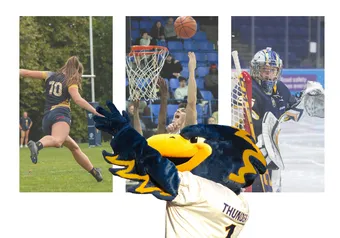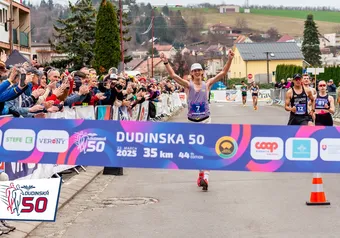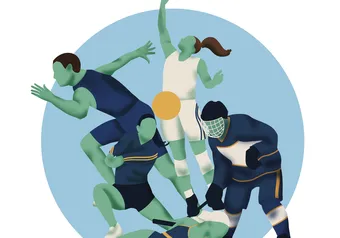The COVID-19 pandemic started to make its impact in North America just as U Sports, Canada’s leading collegiate athletics league, was entering its spring championship season. The immediate result was the last-minute cancellation of most championships, including women’s and men’s ice hockey in March.
Even with most of Canada emerging from the first wave of the virus, U Sports has made the hard but logical decision to cancel first-term competition for the 2020-’21 season, which includes six national championships.
The call didn’t come without controversy, one cause being that as U Sports does not allow athletes to play past the cap age of 24, some players face losing their eligibility before play resumes.
It’s pushed some athletes to look elsewhere. A notable example being former University of Calgary Dino Deane Leonard, who’s signed on to play American college football at the University of Mississippi in the fall.
That’s if there is even a football season this year at Ole Miss. Last month, the school announced that they did intend on still having full crowds for the upcoming football season despite other National Collegiate Athletic Association (NCAA), U Sports’ American counterpart, conferences scrambling for a solution.
Ole Miss and countless other schools across the NCAA’s major conferences have since walked back plans to facilitate sports in the fall. For a country where college campuses feature 80,000-seat football stadiums and basketball arenas that make Rogers Arena look small, the lack of fall sports is going to be noticeable.
If and when university sports return, things are going to look very different. And somehow, even without the largest pandemic that the world has seen in the last 100 years, this was already going to be the case.
Both U Sports and the NCAA were and are due for major changes even without COVID-19.
U Sports rebranded itself to its current form four years ago, dropping ‘Canadian Interuniversity Sport’ for something both easier to remember and bilingual.
With the rebrand came the hunt for more corporate sponsorship and even television deals for national championship coverage with CBC Sports, a reliable, accessible alternative to the expensive, pay-per-view U Sports TV.
But U Sports is never going to be as big as the NCAA, not even on a proportional scale.
Spanning three divisions and over 1,200 member schools, the NCAA is a billion-dollar business even before counting major events like the football championships or March Madness.
A full or partial NCAA scholarship can cover tuition, fees, food, board and course-related books — hence, the reference to NCAA scholarships being the ‘full ride.’ A U Sports scholarship only covers the student's exact amount of tuition and student fees, and they cannot cover any costs related to housing or other living expenses.
The biggest argument around American collegiate play going into 2020 surrounded the strict amateur rules around NCAA athletes. Legislation allowing NCAA athletes to receive compensation for their name and likeness comes down to the state level, and Florida became the first to allow athletes to receive payment for their “name, image and likeness” starting in July 2021.
U Sports athletes are already able to sign sponsorship deals, though Canadian university sponsorships are not nearly as lucrative as professional athletes’ deals. A local example being UBC’s own Emily Overholt and Markus Thormeyer, who are signed to and endorsed by swimwear giant Speedo.
While we could look at the financial statistics or regulation differences when comparing different leagues like U Sports and the NCAA, an often-overlooked source are the student-athletes themselves. This is especially true for UBC, where only a few Thunderbirds have played on both sides of the border.
For former women’s field hockey player Abby MacLellan, playing at Boston’s Northeastern University was another world compared to Thunderbirds.
“[At Northeastern] you're treated almost like a professional athlete and you're just taken all over the place. But, with that too, there's obviously that expectation to perform,” said MacLellan.
“They pay for your tuition, your books, your housing. You get [a] weekly allowance, like spending money … You basically get everything you could ever need.” MacLellan added, since the Prince Edward Island-born athlete attended Northeastern on a ‘full ride’ scholarship.
"You basically get everything you could ever need."
When MacLellan was part of the UBC Thunderbirds, she won two national championships while embracing the ability to explore new avenues academically. “Being at UBC, I'm a student and I'm also an athlete and I kind of wear both of those hats and school is highly prioritized” MacLellan said.
“[At Northeastern] they want you to do well in [academics] as well, but sports is more prioritized. So I find I was missing more school with Northeastern cause we'd be travelling all the time … there'd be a lot less time that I could dedicate to academics because of the intense schedule. ” MacLellan added.
For retired rower and former UBC student Joel Barrette, the experience was similar.
Barrette signed to row for the University of California, Berkeley Golden Bears. While at Berkeley, Barrette enrolled in the school's electrical engineering and computer science program.
While the school did provide Barrette with tutoring and counselling services, there was always a lingering feeling that he should have stuck to an easier program and focused more on athletics.
“The thing that kind of stuck with that was I'd go there and they were, basically the entire time, trying to force me to change my major,” Barrette explained, adding, “I would say it's physically impossible to get an electrical engineering degree there as well as row with the rowing team … There's not enough time in the day.”
His academics showed that he did not struggle in his freshman year due to a career-ending lower back injury.
“I basically was pretty [active] in physio all the time, but a lot of that was just heat and painkillers. I would get stuff done, but ... I wouldn't say that it was getting fixed” Barrette explained.
The injury eventually led Barrette to retire from the sport and leave Berkeley for UBC as, without his scholarship, staying at Berkeley would have meant paying US$55,000 a year in tuition alone.
In her first game as a T-Bird, MacLellan suffered a serious facial injury which caused her to miss the season. Looking back at it, it’s something she’s glad happened at UBC and not Northeastern.
“For me to be injured [at UBC], that doesn't mean that my academics have to stop. Whereas if I had been injured at Northeastern, because the contracts are renewable each year, there could have been a chance that they would have not renewed my contract and [I] would have lost my scholarship and I wouldn't have been able to finish my degree.”
By now, there's a well-established idea that the level of intensity and academic importance exist on completely different levels between U Sports and the NCAA. Choosing to play south of the border doesn’t guarantee a path of success, but choosing Canada also doesn’t necessarily mean an immediate hurdle.
It’s a big reason why graduating standout point guard Jadon Cohee came home after time spent at Seattle University and Southern Utah, joining UBC in 2018 instead of finishing off his NCAA career at premier programs like those in Oregon, Louisville or Xavier.
“I feel like if you’re a top-level player in U Sports, you have a good chance of going professional. That's the reason I came home — because I saw guys, top guys at the U Sports level getting good [professional] contracts, oftentimes getting better contracts than like a major player at the [NCAA] division one level,” Cohee explained.
Cohee's former teammate Conor Morgan confirms this, having gone professional in Spain while still maintaining a regular presence on the Canadian national team, despite the growing number of NBA talent on the roster.
Experiences and results will differ on an individual basis, but it doesn’t take much to see that U Sports and the NCAA are two very different leagues with different philosophies surrounding athletics and academics.
Whether it’s U Sports trying to maintain similar, or at least proportional, footing to the NCAA in Canada or their counterpart trying to navigate the idea of having to let it’s ‘amateur’ athletes claim a rightfully deserved piece of the billion-dollar pie, both leagues are going to come out of this pandemic and season looking very different from each other.
Share this article
First online



![['auto']](https://storage.googleapis.com/ubyssey/media/renditions/Tbird_Stadium20101023Colin_Chia.width-1000.format-webp.webp)
![['auto']](https://storage.googleapis.com/ubyssey/media/renditions/20191129_winter_thunderland_liz.width-1000.format-webp.webp)


